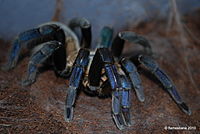- Cobalt blue tarantula
-
Cobalt Blue Tarantula Scientific classification Kingdom: Animalia Phylum: Arthropoda Class: Arachnida Order: Araneae Family: Theraphosidae Subfamily: Ornithoctoninae Genus: Haplopelma Species: H. lividum Binomial name Haplopelma lividum
Smith, 1996The cobalt blue tarantula (Haplopelma lividum) is a tarantula species that is native to Myanmar and Thailand.
Contents
Description
The cobalt blue tarantula is a medium size tarantula with a leg span of approximately 13 cm (5"). The cobalt blue tarantula is noted for its iridescent blue legs and light gray prosoma and opisthosoma, the latter of which may contain darker gray chevrons.[1] Males and females look the same until the ultimate (final) molt of the males. At this point the male will exhibit sexual dimorphism in the form of a light tan or bronze coloration and legginess. Additionally males will gain embolus on the pedipalps and tibial apophysis (mating hooks). The cobalt blue tarantula is a fossorial species and spends nearly all of its time in deep burrows of its own construction.
Habitat
The cobalt blue tarantula inhabits the tropical rain forests of southeast Asia.[2] Here they construct deep burrows, and generally only leave them to find food.
Pets
The cobalt blue tarantula is a mainstay in the pet trade, however it should only be kept by experienced keepers. Being a fast and defensive tarantula with potent venom[3] means that it should not be handled, and its reclusive nature means it is rarely seen. Typical care requirements include a deep tank with 25 to 30 cm (10-12 inches) of substrate such as peat moss or coco-husk.[4] Being from a tropical region they require constant high humidity and should be provided with an open water dish. Tarantulas are generally offered 1-2 prey items (such as crickets) once weekly.
Notes
- ^ Photos of Haplopelma lividum
- ^ * Smith, A. M. (1996). "A new species of Haplopelma (Araneae: Theraphosidae), with notes on two close relatives". Mygalomorph 1: 21–32.
- ^ Tarantulas Bite: Two Case Reports of Finger Bite from Haplopelma lividum. TAKAOKA MAKOTO The Japanese journal of toxicology. vol: 14 issue: 3 page: 247-250 year: 2001
- ^ Schultz, Stanley A. The Tarantula Keeper's Guide: Comprehensive Information on Care, Housing, and Feeding. Barrons, 2009. ISBN 0764138855
External links
- Cobalt Blue Tarantula Care Guide
- Haplopelma lividum at care-sheet.com (WikiPets)
Categories:- Theraphosidae
Wikimedia Foundation. 2010.



